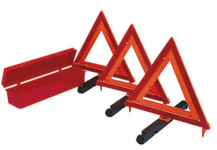This may be a bit off the original topic, but relevant I think to electronic road flares.
A friend I worked with, also into electronics, is a runner, sometimes doing so in low light conditions.
For visibility he created a strip LED arrangement attached to his vest, powered by a Li-ion battery.
The controller flashes LEDs in a pattern of three short flashes with gap between. He believes this
is optimal for getting attention, compared to regular on/off flash, or other patterns.
( I guess such users could be considered "slow-moving vehicles".)
As a small project I designed my own simple controller using a common/cheap IC (CD4060) plus
some resistors, capacitors, diodes and transistor. By changing connections I can get different
patterns including 50% on/off, or 2,4,8 flashes per group with gap between, at various speeds.
A microcontroller such as PIC could give huge number of possible patterns (**), I'm sure it's been
done, but I kept this one simple, such that just about anyone could build it.
The question is, which type of flash sequences would be best for getting attention, but not
too distracting? I know police light bars use a few rapid flashes, alternating between groups.
Assume in this case a single LED, or an array all driven together. A very rapid strobing strikes
me as too distracting, and though I've not heard of specific incidents, might trigger epileptic
seizure in some people.
What are some of these road flare products doing?
Dave
** An aside, one cheap bike rear light from dollar store provides 6-7 different patterns which I find
annoying. You may need to cycle through several to get the one you want, and turn it off. I also
question the safety/legality of a directional pattern which seems to be indicating a turn, other
than intended, even on a bicycle. Simple high/low/flash would have been fine.


